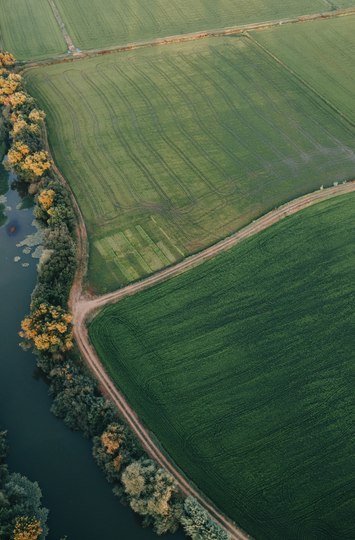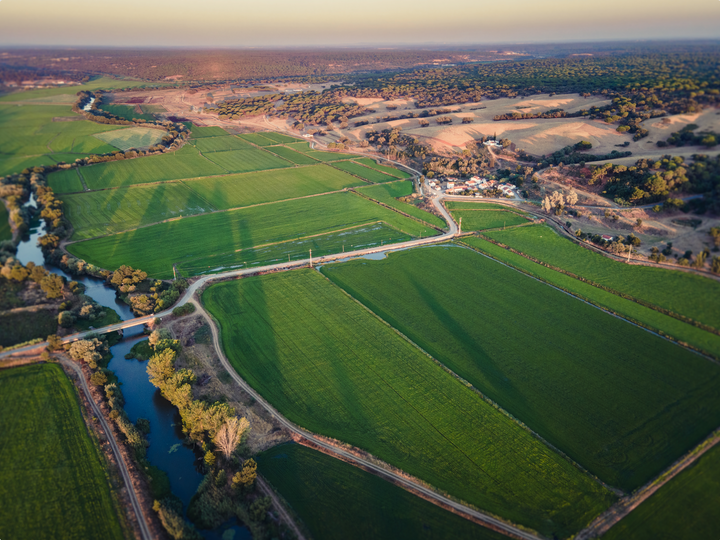
ITINERARY 3
AGRICULTURE IN TORRÃO: MORE THAN 500 YEARS OF HISTORY
At the rhythm of nature's cycles, Torrão, a village to the south, knew how to live up to its fertile soils and Mediterranean climate, working the land over several generations, assuming agriculture as its main economic activity. Visiting Torrão requires setting out to discover its main agricultural holdings, from cork oak forests to olive groves, not forgetting the lush rice fields.
Visiting the new local productions, knowing the particularities and cycles of each agricultural activity, understanding how each one of them marks the surrounding landscape and contributes to a new economic flourishing of the region, are the main objectives of this itinerary focused on different experiences to live. Meet local producers and taste the best that is produced in Torrão.
See below the description of the points to visit and know more about the additional experiences.
Useful information
Duration: 1 day
Total distance: 50 km
Recommended transportation: by car
Recommended age: All ages
Level of Difficulty: Easy
1. Herdade de Vale da Arca
Herdade de Vale de Arca is located in a village with the same name at the confluence of Alto Alentejo, Baixo Alentejo and Alentejo Litoral. It has a privileged geographical situation as it is at the epicenter of a circle made up of the main Alentejo cities, from which it is about half an hour away. In this village, made up of 26 houses, a primary school, a grocery store and a café, they lived until the 1980s, about 120 people.
The farm of Herdade de Vale de Arca currently has 1200 hectares. Starting from a nucleus of olive trees from the 19th century. In the 15th century, the olive grove project covers approximately 600 hectares, taking advantage of course, the two existing dams, inexhaustible sources of water, which ensure irrigation throughout the year. The concern with the ecological balance and the existing species in the habitat, led to the fact that during the Olival plantation, none of the existing cork oaks were destroyed, with cork being another of the Herdade's business areas.
Currently committed to distinguishing itself in the area of local tourism, it intends to offer those who visit it an unforgettable leisure experience, including horseback riding, water skiing, as well as shooting, hunting and sport fishing.
Come and visit Herdade de Vale da Arca and delight yourself with some of its products!
To visit, contact: 265 669 127 or info@valedearca.com
3. Cooperativa Agrícola dos Olivicultores do Torrão
The production of olive oil is intrinsically associated with the history of this Alentejo village. Just by looking at the surrounding landscape, we quickly realize the economic, cultural and social impact that this production has on a small population like Torrão. The Cooperativa Agrícola dos Olivicultores do Torrão has its own facilities for the transformation of olives, coming from olive groves of small and medium producers, in high quality olive oil that is consumed locally and sold abroad by the respective brands.
A visit to the Cooperative enlightens any visitor about the production processes of olive oil, one of the most distinctive products of agricultural production in the region, a symbolic element that marks the Alentejo's gastronomic experiences and traditions, since ancient times. Stay for a taste of Xarraminha Olive Oil, produced at Cooperativa do Torrão!
To visit, contact: 265 669 252 or cooperative . torrao @sapo.pt
2. Herdade do PortoCarro
The Herdade do PortoCarro, located in São Romão, one of the parishes of Vila do Torrão, has a rice meadow, next to the Sado, where rice is produced with its own brand - LOVERICE - and an area of slopes facing south, where the 18 hectares of vineyard. The name of the company is primarily inspired by the existence of a high point, formerly called “car”, located at the highest point in the region. Secondly, the small pier, Porto Rei, which has marked the landscape for many centuries, since the times when goods were transported mainly by river.
This region, with roots in antiquity, as evidenced by the traces of coins and wine amphorae found in this area, is marked by the crossing of the River Sado, which results in a particular climate that contributes to the production of deeply original wines — such as the Herdade do PortoCarro, Anima and Cavalo Maluco — which can be tasted on a visit to the Herdade.
To visit, contact: cpintopereira@portocarro.com
4. São Romão and the Rice Fields
Visit São Romão, a small village, grouped in the parish of Torrão at the end of 1936, and experience the tranquility of an Alentejo village in full communion with nature.
This small village of great historical wealth was the residence of the African community that, from the 16th century onwards, came to work on rice cultivation. From São Romão, next to the Church of São Romão, next to the cemetery, we can enjoy one of the most incredible landscapes in the region: the rice field as far as the eye can see, in the green floodplain punctuated by the storks characteristic of the region.
The rice fields are worked since the end of winter, so that throughout the summer the rice can grow and mature, slowly preparing for harvest in October. This peculiar landscape in the parish of Torrão is present in abundance in the Vale do Sado area, with Alcácer do Sal distinguishing itself as one of the largest producers in the country.
Visit São Romão, reconnect with nature and discover the true tranquility of Alentejo!
5. Porto Rei
We suggest a stop, in the middle of the Sado lezíria, at the ruins of Porto Rei, a port of great importance in terms of trade made from the River Sado, when it was navigable up to this point.
This area was colonized from 1483 onwards by black slaves brought from African factories, due to the pests and diseases that decimated the white populations. The economic impact and the harshness of agricultural work in this territory led to the extension of slavery, abolished in Portugal in 1761, but maintained in Porto Rei until 1806, according to the documentation.
Known at the time of the Romans as Callipus, and, probably from the Islamic occupation, as Sadão, the Sado was always a generator of life, because, by flooding the land, it fertilizes it, allowing water and land to be, effectively, the great reasons for people to settle in this region.
















